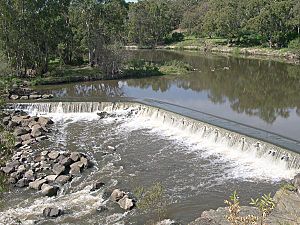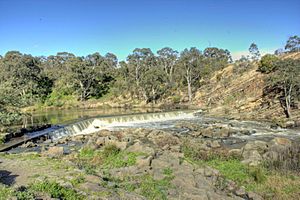Dights Falls facts for kids
Dights Falls is a special place on the Yarra River in Melbourne, Victoria. It's where the river has a fast-moving section called a rapid, and a small wall called a weir. This spot is just after the Merri Creek joins the Yarra.
Here, the river flows between two very different types of rock. On one side, there's 800,000-year-old volcanic rock. On the other, there's much older sedimentary rock, which is made from layers of sand and mud that hardened over time. You can even find tiny graptolite fossils in the sandstone on the north side!
Contents
History of Dights Falls
First People and Early Explorers
Long before European settlers arrived, the Wurundjeri people lived in this area. They were part of the Kulin nation. Dights Falls was a natural crossing point for them. It was also a great place to catch fish moving up or down the river. The falls were an important meeting spot where different groups would trade, solve problems, and even arrange marriages.
In 1803, a surveyor named Charles Grimes explored the Yarra River by boat. He reached Dights Falls on February 8, 1803. This was the first time a European person saw the falls. A special marker on a hill nearby remembers this event. It also notes that the first cattle crossing of the river happened here in 1836.
The Mill and the Weir
In 1839, a man named John Dight bought land next to the falls. He was a flour miller. By 1841, he had built a mill that used the river's water power. He also built a small weir (a low dam) on the natural rocks to help control the water for his mill's water wheel.
Over the years, the property changed owners many times. The mill was eventually destroyed by fire in the early 1900s. Even today, this site is important because it's one of Melbourne's oldest industrial areas.
Upgrades and Fishways
The weir at Dights Falls was improved in 1895. At that time, it was the biggest water-powered system in Victoria. It was even Victoria's first hydro-electric plant, meaning it used water to make electricity! The weir was rebuilt several times after floods, including in 1918, 1940, and 1967.
In 1993, Melbourne Water realized the weir was making it hard for fish to swim up the Yarra River. So, they built a special "fish ladder" to help the fish get past the weir. However, later studies showed it wasn't working perfectly. Because of this, Melbourne Water started new work in 2010 to replace the weir and build an even better fishway.
What You Can Do There Now
Dights Falls is a popular spot for outdoor activities.
- Walking and Cycling: You can easily get to the area by walking or cycling on the Yarra River Trail. It's a great place for a scenic stroll or bike ride.
- Canoeing: The rapid at Dights Falls is often used for canoeing. It has even hosted the Victorian Canoe Slalom Championships many times!
- Wildlife: You might see magpies flying around. Some people say that the famous Collingwood Football Club chose the magpie as their team mascot because of the magpies at Dights Falls!



